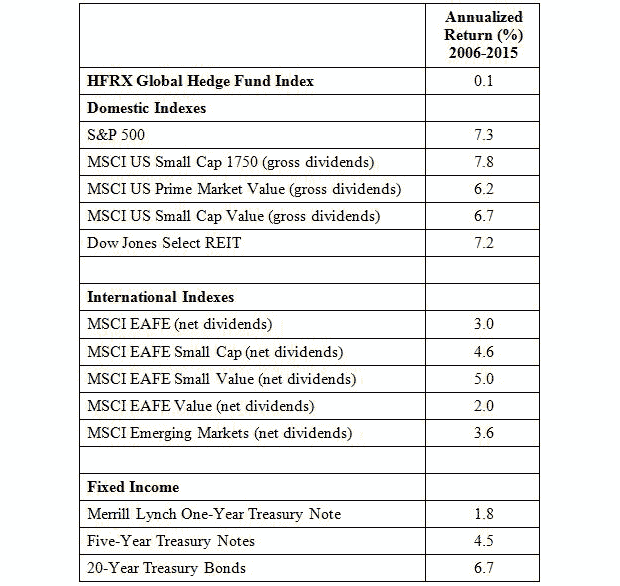Swedroe: Pension Funds Turn In Vain To Hedge Funds
By Larry Swedroe
Hit by a “perfect storm” that combined a decade (2000-2009) in which the S&P 500 lost about 1% a year with a rising tide of pension obligations, public workers’ pension funds across the country increasingly began turning to riskier alternative investments (such as hedge funds) in an effort to boost returns and close the gaps in their underfunded plans.
Unfortunately, taking greater risk with such investments hasn’t produced the hoped-for results. In fact, it seems these efforts have only worsened the situation for beneficiaries. The big winners have been the purveyors of such investments, who earn much higher fees than those charged for passively managed funds—such as index mutual funds and ETFs—that invest in publicly available securities.
Shortchanged Students
The latest evidence of bad outcomes is from a March 2016 paper, “Missing the Mark: How Hedge Fund Investments at the University of California Shortchange Students, Staff and California Taxpayers.” The study, by the UC system’s largest employee union, AFSCME Local 3299, found that the University of California’s 12-year experiment with hedge fund investments, with more than $6 billion currently invested in them, had failed to deliver on their twin promises of downside protection and superior returns. Among the study’s key findings were:
- UC paid hedge fund managers $1 in fees for every $2 generated in net returns. The UC system could have saved $950 million in fees and generated the superior returns it sought by investing in low-cost, traditional asset classes.
- Because of the extraction of large management and performance fees from gross returns, the UC system’s hedge fund holdings have routinely underperformed its overall pension and endowment funds, costing more than $783 million in investment returns over 12 years.
- Despite the claims that hedge funds invest in uncorrelated assets, there was a strong positive correlation (0.87) between UC’s hedge funds and the market. In bear and bull markets alike, UC paid upward of $1 billion in fees for returns that largely mirrored the trends in the stock market.
- Despite their claim to provide “absolute returns,” hedge fund investments produced negative returns in two of the 10 years prior to the study, including a loss of 13% in 2008 (when the UC system’s bond portfolio returned 6%). In 2011, when the S&P 500 returned 5.5% and the Barclays Aggregate Bond Index returned 7.5%, investments in hedge funds lost 2%.
- Over 12 years, the University of California’s absolute-return hedge fund program yielded a cumulative 112% in net returns. Excluding hedge fund investments, the returns were 168%.
Long-Term Underperformance
None of these results should be surprising to investors who have been following the industry. For example, 2015 was the seventh-straight year that the HFRX Global Hedge Fund Index underperformed the S&P 500 Index. For the 10-year period 2006 through 2015, the HFRX Global Hedge Fund Index returned just 0.1% per year and underperformed every single major equity and bond asset class. The table below shows the returns of the various indexes:

For the full article, click on the link below.
[Source]: ETF.com


